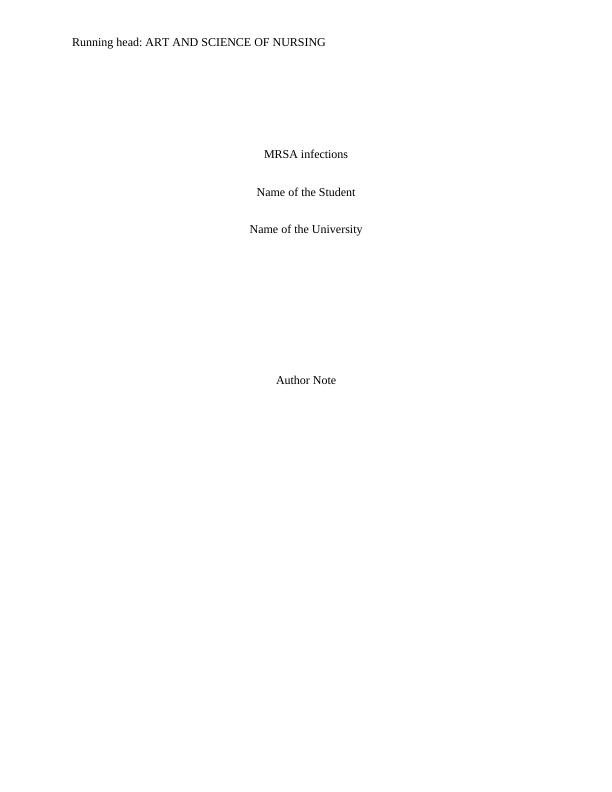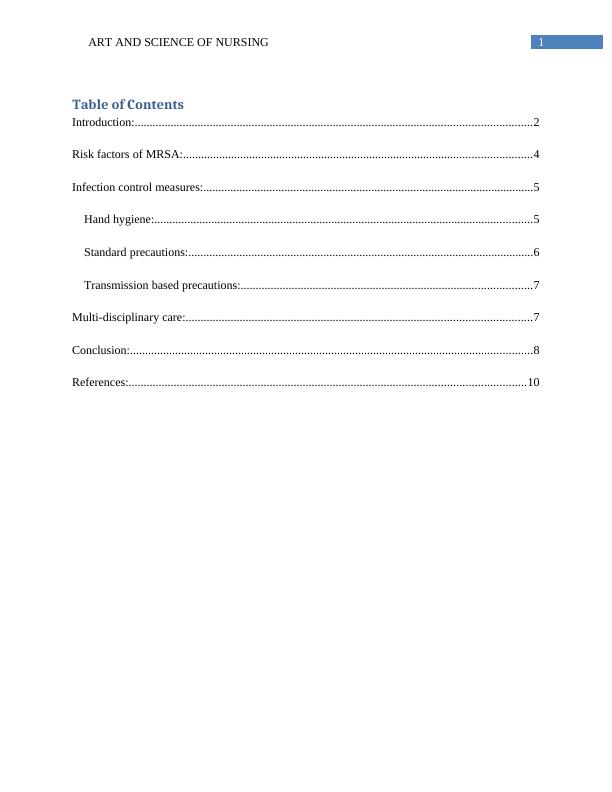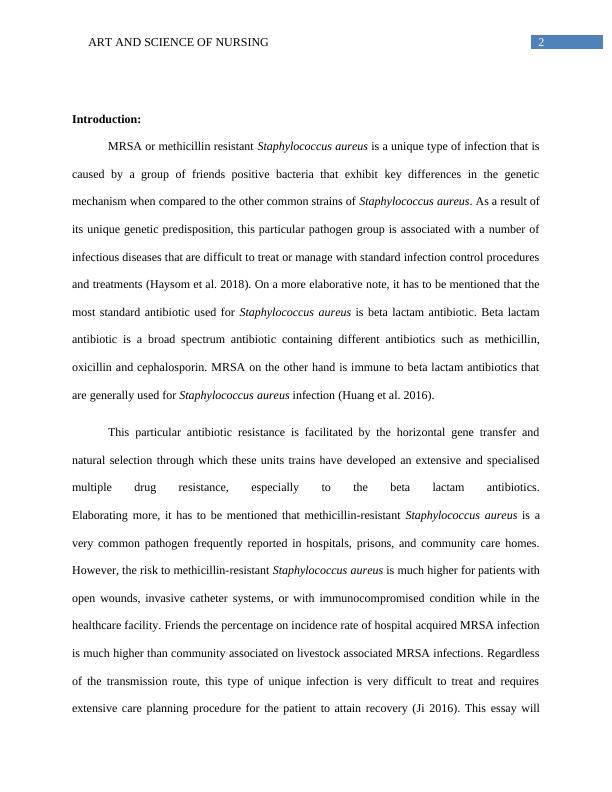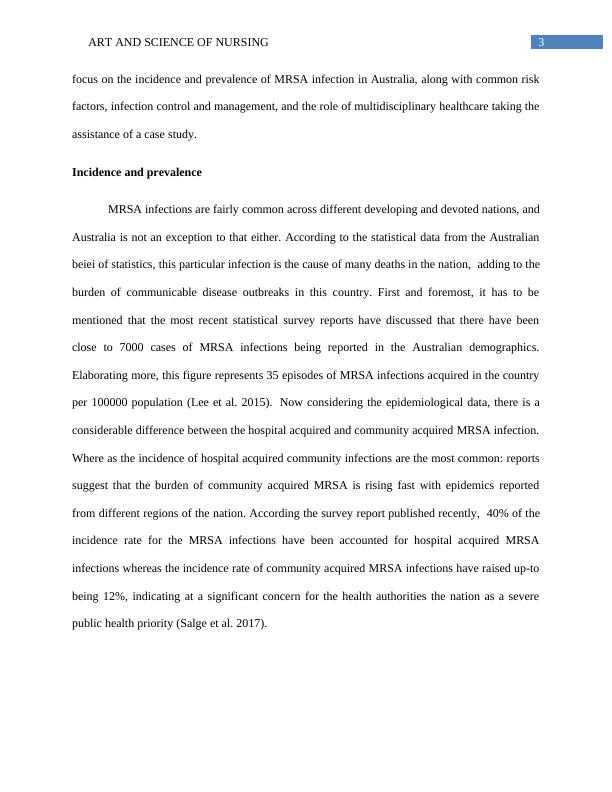The Art and Science of Nursing
13 Pages3341 Words26 Views
Added on 2021-05-31
The Art and Science of Nursing
Added on 2021-05-31
ShareRelated Documents
Running head: ART AND SCIENCE OF NURSINGMRSA infectionsName of the StudentName of the UniversityAuthor Note

1ART AND SCIENCE OF NURSINGTable of ContentsIntroduction:....................................................................................................................................2Risk factors of MRSA:....................................................................................................................4Infection control measures:..............................................................................................................5Hand hygiene:..............................................................................................................................5Standard precautions:...................................................................................................................6Transmission based precautions:.................................................................................................7Multi-disciplinary care:...................................................................................................................7Conclusion:......................................................................................................................................8References:....................................................................................................................................10

2ART AND SCIENCE OF NURSINGIntroduction: MRSA or methicillin resistant Staphylococcus aureus is a unique type of infection that iscaused by a group of friends positive bacteria that exhibit key differences in the geneticmechanism when compared to the other common strains of Staphylococcus aureus. As a result ofits unique genetic predisposition, this particular pathogen group is associated with a number ofinfectious diseases that are difficult to treat or manage with standard infection control proceduresand treatments (Haysom et al. 2018). On a more elaborative note, it has to be mentioned that themost standard antibiotic used for Staphylococcus aureus is beta lactam antibiotic. Beta lactamantibiotic is a broad spectrum antibiotic containing different antibiotics such as methicillin,oxicillin and cephalosporin. MRSA on the other hand is immune to beta lactam antibiotics thatare generally used for Staphylococcus aureus infection (Huang et al. 2016). This particular antibiotic resistance is facilitated by the horizontal gene transfer andnatural selection through which these units trains have developed an extensive and specialisedmultiple drug resistance, especially to the beta lactam antibiotics.Elaborating more, it has to be mentioned that methicillin-resistant Staphylococcus aureus is avery common pathogen frequently reported in hospitals, prisons, and community care homes.However, the risk to methicillin-resistant Staphylococcus aureus is much higher for patients withopen wounds, invasive catheter systems, or with immunocompromised condition while in thehealthcare facility. Friends the percentage on incidence rate of hospital acquired MRSA infectionis much higher than community associated on livestock associated MRSA infections. Regardlessof the transmission route, this type of unique infection is very difficult to treat and requiresextensive care planning procedure for the patient to attain recovery (Ji 2016). This essay will

3ART AND SCIENCE OF NURSINGfocus on the incidence and prevalence of MRSA infection in Australia, along with common riskfactors, infection control and management, and the role of multidisciplinary healthcare taking theassistance of a case study.IncidenceandprevalenceMRSA infections are fairly common across different developing and devoted nations, andAustralia is not an exception to that either. According to the statistical data from the Australianbeiei of statistics, this particular infection is the cause of many deaths in the nation, adding to theburden of communicable disease outbreaks in this country. First and foremost, it has to bementioned that the most recent statistical survey reports have discussed that there have beenclose to 7000 cases of MRSA infections being reported in the Australian demographics.Elaborating more, this figure represents 35 episodes of MRSA infections acquired in the countryper 100000 population (Lee et al. 2015). Now considering the epidemiological data, there is aconsiderable difference between the hospital acquired and community acquired MRSA infection.Where as the incidence of hospital acquired community infections are the most common: reportssuggest that the burden of community acquired MRSA is rising fast with epidemics reportedfrom different regions of the nation. According the survey report published recently, 40% of theincidence rate for the MRSA infections have been accounted for hospital acquired MRSAinfections whereas the incidence rate of community acquired MRSA infections have raised up-tobeing 12%, indicating at a significant concern for the health authorities the nation as a severepublic health priority (Salge et al. 2017).

End of preview
Want to access all the pages? Upload your documents or become a member.
Related Documents
Report on Healthcare and Life Sciences Quizlg...
|4
|756
|44
The Royal College of Physicians Ireland Reportlg...
|17
|4455
|46
Controlling Transmission of Healthcare Acquired Methicillin-Resistant Staphylococcus Aureus (HA-MRSA) Infectionslg...
|12
|4091
|470
Acquired Infectionlg...
|11
|3129
|339
Methicillin-Resistant Staphylococcus Aureus (MRSA)lg...
|13
|3912
|377
Effectiveness of Interventions to Prevent MRSA Infection in Hospitalslg...
|17
|4823
|27
